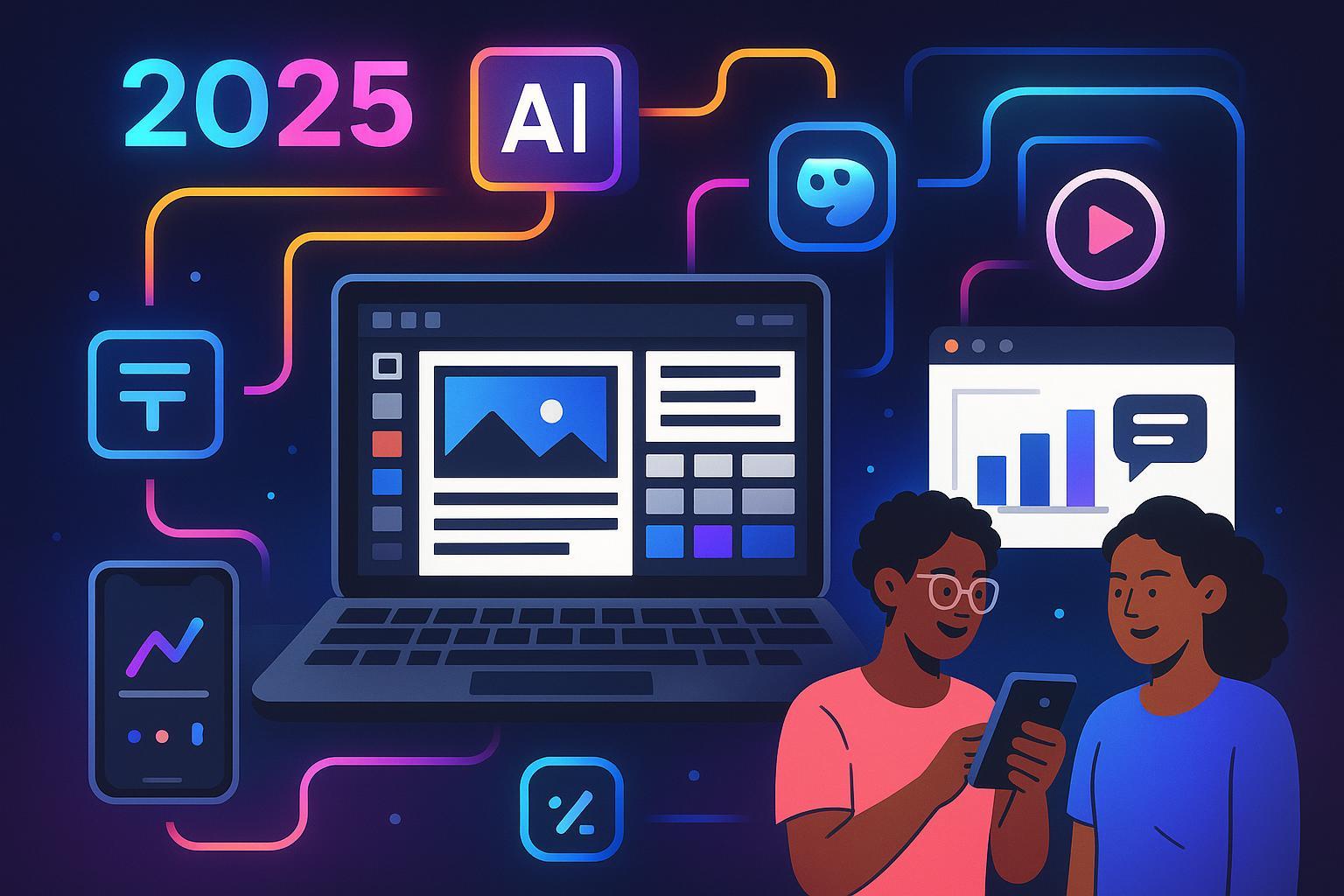38 Best AIGC Tools for Digital Content Creators in 2025

Updated for 2025 with innovative solutions, emerging categories, and professional benchmarks.
Selection Criteria:
Technological innovation
Ease of use
Cost-effectiveness
Compatibility with mainstream content workflows
Highlighted underrated categories: block editors, multilingual AI, analytics platforms
This list is regularly updated to ensure continued relevance and actionable guidance for digital creators, marketers, and teams.
📝 Writing & Editing
1. QuickCreator
AI-powered blog/article creation platform with block-based editor, real-time SEO analysis, and one-click publishing. Multilingual support and seamless media integration make it ideal for marketers, agencies, and small teams seeking fast, high-quality content production. Best for scalable workflows and global content strategies.
Explore QuickCreator
2. ChatGPT (OpenAI)
Flagship conversational AI for content ideation, editing, and research. Streamlines writing workflows, brainstorms creative solutions, and drafts everything from long-form articles to social media posts. Versatile for individuals and large teams alike.
Learn about ChatGPT
3. Jasper AI
Advanced long-form writer, marketing copy generator, and collaborative content suite. Automates blog, ad, and email writing based on detailed briefs or templates; integrates with major CMSs. Great for agencies and growth hackers.
Discover Jasper
4. Claude (Anthropic)
Ethical, privacy-first LLM for contextual writing and editing with deep understanding. Best for sensitive brand communication and AI-assisted creative teams.
Read about Claude
5. Copy.ai
Rapid-fire marketing copy wizard for brainstorming, drafts, and tailored messaging. Automation-friendly with extensive prompt templates. Suited to short-form, dynamic campaigns.
Try Copy.ai
6. Grammarly
AI grammar correction, clarity enhancement, and plagiarism-checking for professional polish. Ideal for writers seeking error-free, persuasive copy.
Grammarly Official
7. Rytr
Budget-friendly AI text generator with multilingual support; excels at social and blog content. Best for solo creators and micro-businesses.
Explore Rytr
8. DeepL Write
Multilingual AI-enhanced writing tool focused on clarity and tone across languages. Great for international teams and non-native writers.
Try DeepL Write
🎨 Design, Image & Multimedia Generation
9. Canva
Intuitive design platform augmented with AI text/image generation and easy publishing tools. Powers brand visuals, social posts, presentations—with strong template support.
Use Canva AI
10. Midjourney
Discord-based generative art AI for vivid, original imagery. Versatile for blog headers, thumbnails, concept art, and visual storytelling.
See Midjourney
11. DALL-E
OpenAI’s leading text-to-image generation engine for custom illustrations, mockups, and infographics—direct API integration for workflow automation.
Try DALL-E
12. Luma AI
3D asset generation and innovative visual content creation for AR/VR, ecommerce, and product showcases. Great for forward-looking brands.
Learn about Luma AI
13. Runway ML
Video editing, generative motion graphics, and real-time AI video creation—used by studios for content repurposing and branded stories.
Explore Runway
14. Stable Diffusion
Open-source image generator for high-resolution, customizable visuals. Best for devs/designers needing adaptable, private solutions.
Find Stable Diffusion
🎥 Video, Audio & Repurposing
15. Synthesia
AI video avatar platform—turns text and scripts into scalable, multilingual video presentations. Ideal for training, branding, and social media.
Synthesia Official
16. Descript
Audio/video editing with auto-transcription, voice cloning, and podcast enhancement—streamlines production for content and marketing teams.
Try Descript
17. ElevenLabs
High-fidelity voice synthesis for natural-sounding narration, character voices, and multilingual audio.
Learn ElevenLabs
18. OpusClip
Smart video repurposing—from long-form to viral shorts, automatic clip creation for TikTok/YouTube.
OpusClip Info
19. Repurpose.io
Automate content distribution by converting and publishing podcasts, live streams, and videos to social platforms. Best for creators distributing across many channels.
Use Repurpose.io
🌏 Multilingual & Localization AI
20. Bertha AI
AI for multilingual website copywriting—especially WordPress users. Makes global outreach easy for creators, agencies, and microbrands.
Learn Bertha AI
21. Deepseek
Multilingual LLM optimized for Asian languages and global translation tasks. Vital for international content marketing.
Explore Deepseek
22. Lokalise AI
Automates localization workflows for creatives and SaaS teams—translates, proofreads, and adapts content for new markets.
Visit Lokalise AI
📊 Analytics, SEO & Optimization
23. Surfer SEO
AI-based SEO content audit and strategy platform. Delivers keyword and SERP analysis to optimize blog posts and landing pages for organic reach.
Surfer SEO Official
24. Frase AI
Content brief generation + competitive SERP research = AI-powered planning and writing. Best for agencies, bloggers, and growth marketers.
Try Frase
25. MonkeyLearn
AI analytics for text classification, sentiment analysis, and content data visualization to supercharge editorial strategy. Great for media managers and analytics-driven teams.
Discover MonkeyLearn
26. Clearscope
SEO optimization tools leveraging AI scoring and competitive analysis. Simplifies complex ranking factors for content teams.
Clearscope Info
27. Perplexity AI
Next-gen research and content analysis, pulling live data for high-accuracy sourcing and fact-checking. Useful for journalists and academics.
Visit Perplexity
🔗 Block-Based Editors & Visual Web Builders
28. Typedream
Block-style website builder powered by AI copy and design prompts—ideal for creators launching new brands or portfolios.
Try Typedream
29. Wix ADI
Wix’s AI Design Intelligence: drag-and-drop plus auto-generated copy and images for rapid, good-looking sites.
Build with Wix ADI
30. Softr
No-code, block-powered website/app builder with AI workflows and flexible integrations—great for creators, startups, and freelancers.
Explore Softr
🤝 Collaboration, Planning & Workflow
31. Notion AI
All-in-one doc/knowledge/workflow platform with built-in generative AI for notes, wikis, content calendars, and creative planning. Fits solo and team workflows.
Get Notion AI
32. ClickUp AI
Generative task planning, project chat, and idea generation for marketing and content ops. Powerful for cross-team productivity.
Try ClickUp AI
33. ContentStudio
AI-enhanced social publishing, curation, and influencer discovery for larger media teams and brands. Makes multi-channel management efficient.
ContentStudio Official
34. Airtable AI
Smart data organization, editorial calendar, and collaborative production tools, now with quick AI-powered summarization and automation.
Explore Airtable AI
35. Slite AI
Knowledge management and team documentation with AI summarization and writing. Great for distributed content teams.
🏆 Niche Innovations & Hidden Gems
36. TopView AI
Video content insights, performance prediction, and optimization for social virality. Best for TikTok and short-form video strategists.
Try TopView
37. QuillBot
Paraphrasing, summarization, and writing style transformation; excellent for academic, technical, or editorial teams needing fresh takes.
Check QuillBot
38. ContentBot
Automates blog ideas, outlines, and short-form content for startups and content creators—special strength in rapid ideation.
Explore ContentBot
🔎 How To Choose? Frequently Asked Questions
Q: Which AIGC tool is best for blog creation?
QuickCreator, Jasper AI, and ChatGPT lead for robust workflows—QuickCreator stands out for block editing, automatic SEO, and multilingual output.
Q: What’s a top AI image generator?
Midjourney for original art; Canva for marketing and cross-platform assets.
Q: Can I automate content for multiple languages?
Yes—tools like Bertha AI, DeepL Write, and QuickCreator specialize in multilingual output.
Q: Where should digital creators focus in 2025?
Integrated workflows, analytics-powered planning, and cross-channel repurposing—block editors, multilingual AI, and content analytics are must-haves.
🚀 Ready to Boost Your Creation Workflow?
Share, bookmark, and revisit—this list is your 2025 digital creator’s toolkit! For detailed reviews or deeper dives into each workflow, follow the official tool links or watch for future updates.
Have a must-try AI tool missing here? Suggest it below and help keep the creator community cutting edge!
Article last updated: August 2025. Rankings based on live user reviews, industry expert insights, and latest features. Reference sources: Synthesia's AI tools 2025, DemandSage AI tool guide, TopView AI Blog 2025.

